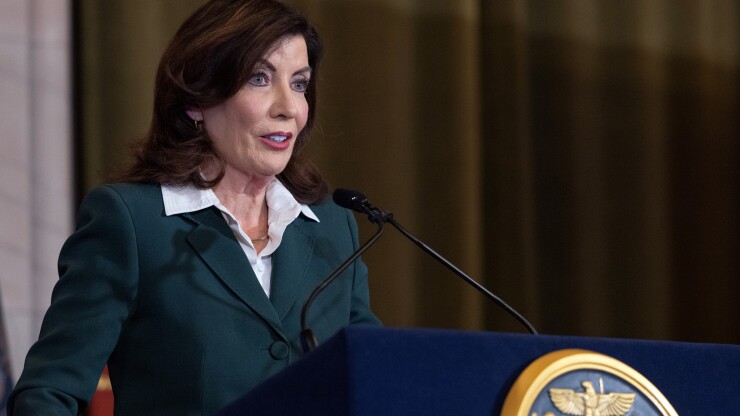New York City has received a boost of state support as it seeks to head off a worsening affordable housing crisis, including an increase in the bonding capacity of the New York City Housing Development Corp.
Gov. Kathy Hochul this week signed into law a trio of bills passed by New York’s Legislature leveraging state resources to accelerate the construction and preservation of “more affordable, sustainable and sorely needed housing” in New York City.
“By increasing the availability of municipal housing bonds, this legislation will support the creation and preservation of more affordable housing in New York City, as well as support critical investments in public housing,” the governor’s office said in a statement.
Office of Gov. Kathy Hochul/Mike Groll
New York has faced a worsening crisis as costs outstrip median incomes and construction of new units lag behind population increases.
The state legislation adds to city efforts to address the problems. New York City Mayor Eric Adams, eyeing a goal of 500,000 new homes constructed in the city over the next decade, welcomed the new laws.
“… Our administration is moving aggressively to make the changes we can at the city level to build much-needed housing,” Adams said in a statement. “Our partners in government increasingly understand the need for bold action to address the city’s affordability crisis.”
One of the new provisions raises the city’s Housing Development Corporation debt limit to $19 billion from $18 billion, which the governor’s office said will help development financing keep pace with construction goals issued by Adams.
“Without an increase, HDC is expected to run out of bonding capacity by mid-2024,” Barclays PLC said Friday in a weekly municipal market report. “An increase to HDC’s bond cap will enable it to continue its mission to expand and preserve the city’s supply of affordable and public housing, which is more critical than ever in the wake of the pandemic.”
The HDC is the nation’s largest issuer of affordable multifamily housing revenue bonds. The agency has about $15.2 billion of outstanding securities and plans to issue $2.4 billion more by the end of the calendar year. The issuer earlier this week was in the market with $125 million of taxable index floating rate sustainable development multifamily housing bonds.
The NYC HDC is rated Aa2 by Moody’s Investors Service and AA-plus by S&P Global Ratings.
Additional laws Hochul signed included S.4709A/A.7758, which provides for property tax benefits to contractors working to preserve and improve affordable multifamily dwellings in the city, replacing the former J-51 program that expired on June 29. The incentives would be “critical to supporting low- and moderate-income families and ensuring the city and state do not lose ground,” state officials said.
Barclays’ report noted the new incentive program amounted to a tax abatement for relevant property owners of 70% on the cost of eligible construction projects, capped at 8.3% per year for no more than 20 years.
A third bill, the Housing Affordability, Resiliency, and Energy Efficiency Investment Act of 2023, updates existing financing laws to support the construction and rehabilitation of affordable housing units.
It would give New York City greater flexibility in providing loans and grants for related investment and contains provisions for green energy and resiliency upgrades, Hochul’s office said in a statement.
“The legislation also allows the city to use municipal funds to provide down payment assistance to prospective homebuyers,” they added. “By giving the city more flexibility to provide loans and grants, this legislation will help to create and preserve more affordable housing, expand homeownership opportunities for more New Yorkers, and support the state’s climate resiliency and energy efficiency goals.”
New York’s housing issues are rooted in a lack of supply, experts said.
While housing costs have risen across much of the United States over the past decade, new construction in New York City has lagged behind other major cities.
Since 2010, the city saw a 22% increase in jobs with just a 4% increase in housing stock, Pew Research reported.
Pew said from 2017 to 2021, New York City permitted just 13 homes for every 1,000 residents while Boston added 28, Washington, D.C., 43, and Seattle, 67. The city’s suburbs also contributed to the lack of available housing, they added.
“New York’s lack of building doesn’t represent weak demand for housing, because its low vacancy rates and high rents indicate strong demand for homes,” Pew said. “Instead, rigid local regulations and cumbersome permitting processes have made building difficult, especially for lower-cost homes such as apartments, houses on small lots, units without off-street parking, and accessory dwelling units, such as basement, garage, or backyard apartments”
